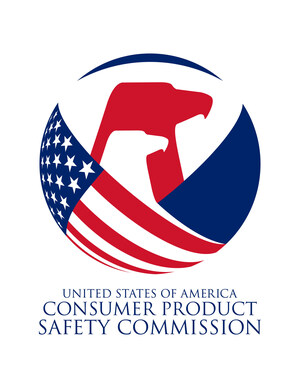WASHINGTON, Feb. 1, 2022 /PRNewswire/ -- As massive winter storms threaten a large swath of the United States, moving swiftly from the Rockies through the Midwest, and up to New England, the U.S. Consumer Product Safety Commission (CPSC) is urging consumers to take steps to protect themselves from carbon monoxide (CO) poisoning and fires.
Consumers need to be especially careful during a loss of electrical power. Many use portable generators and other devices for sources of power and heat, exposing themselves to increased risk of CO poisoning and fire.
CO is called the "invisible killer" because it is colorless and odorless. CO poisoning from portable generators can happen so quickly that exposed persons can become unconscious before recognizing the symptoms of nausea, dizziness, or weakness. CPSC estimates that more than 80 consumers die each year from CO poisoning caused by portable generators.
Consumers who plan to use a portable generator during a power loss should follow these tips:
Loss of Power—Using a Generator Safely
- Operate portable generators outside only, at least 20 feet away from the house, and direct the generator's exhaust away from the home and any other buildings that someone could enter.
- Never operate a portable generator inside a home, garage, basement, crawlspace, shed, or on the porch. Opening doors or windows will not provide enough ventilation to prevent the buildup of lethal levels of CO.
- Check that portable generators have had proper maintenance, and read and follow the labels, instructions, and warnings on the generator and in the owner's manual.
- When purchasing a portable generator, CPSC urges consumers to look for and ask retailers for a portable generator equipped with a safety feature to shut off automatically when high CO concentrations are present around the generator. Some models with a CO shut-off feature also have reduced emissions; consumers should look for those models as well. These models may or may not be advertised as certified to the latest safety standards for portable generators - PGMA G300-2018 and UL 2201.
Check CO and Smoke Alarms
To help avoid carbon monoxide poisoning:
- Install battery-operated CO alarms or CO alarms with battery backup at home, outside separate sleeping areas, and on each floor of the home.
- Make sure CO alarms at home are working properly, by pressing the test button and replacing batteries, if needed. Never ignore a carbon monoxide alarm when it sounds. Get outside immediately. Then call 911.
Dangers with Charcoal and Candles
- Never use charcoal indoors. Burning charcoal in an enclosed space can produce lethal levels of carbon monoxide. Do not cook on a charcoal grill in a garage, even with the door open.
- Use caution when burning candles. Use flashlights instead. If using candles, do not burn them on or near anything that can catch fire. Never leave burning candles unattended. Extinguish candles when leaving the room and before sleeping.
- Make sure smoke alarms are installed on every level of the house and inside each bedroom. Never ignore a ringing smoke alarm. Get outside immediately. Call 911.
Space Heater Safety
- With winter conditions bringing below freezing temperatures, consumers may use space heaters for extra warmth. Make sure to keep flammable materials at least three feet away. Always plug space heaters directly into a wall outlet and never into a power strip, to prevent overloading and causing a fire.
- CPSC estimates that portable heaters are involved in about 1,700 fires per year, resulting in about 80 deaths and 160 injuries annually.
- A CPSC staff report found that space heaters can also present a hyperthermia (overheating) hazard to consumers, particularly children, people with disabilities and senior citizens, who may be more susceptible because of their limited ability to act or react to the elevated ambient temperature.
- Hyperthermia can result in death. DO NOT leave space heaters running unattended in a confined space around infants or individuals with reduced physical, sensory or mental capabilities.
CPSC resources:
Carbon Monoxide Safety Center
Link to broadcast quality video for media:
Winter Storm safety b-roll: https://spaces.hightail.com/space/Nf1RH1JDGn
For more information, contact Nicolette Nye at: [email protected], or at: 240-204-4410.
About the U.S. CPSC
The U.S. Consumer Product Safety Commission (CPSC) is charged with protecting the public from unreasonable risks of injury or death associated with the use of thousands of types of consumer products. Deaths, injuries, and property damage from consumer product incidents cost the nation more than $1 trillion annually. CPSC's work to ensure the safety of consumer products has contributed to a decline in the rate of injuries associated with consumer products for nearly 50 years.
Federal law bars any person from selling products subject to a publicly announced voluntary recall by a manufacturer or a mandatory recall ordered by the Commission.
For lifesaving information:
- Visit CPSC.gov.
- Sign up to receive our e-mail alerts.
- Follow us on Facebook, Instagram @USCPSC and Twitter @USCPSC.
- Report a dangerous product or a product-related injury on www.SaferProducts.gov.
- Call CPSC's Hotline at 800-638-2772 (TTY 301-595-7054).
- Contact a media specialist.
Release Number: 22-065
SOURCE U.S. Consumer Product Safety Commission

WANT YOUR COMPANY'S NEWS FEATURED ON PRNEWSWIRE.COM?
Newsrooms &
Influencers
Digital Media
Outlets
Journalists
Opted In




Share this article